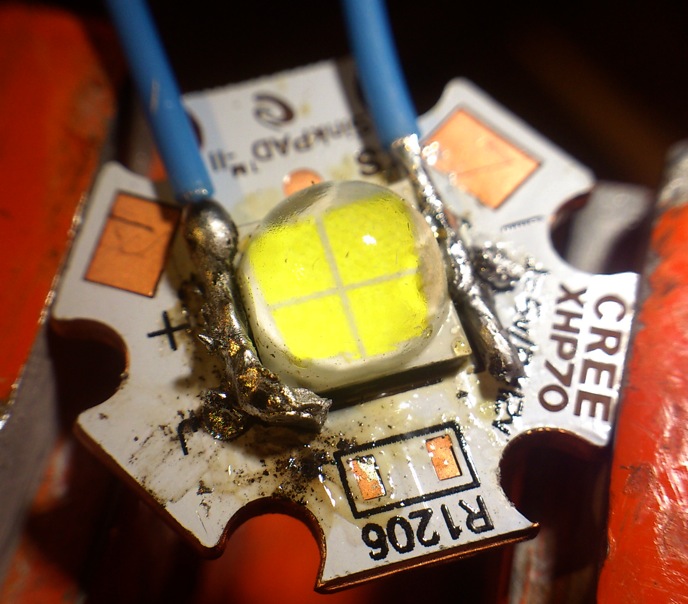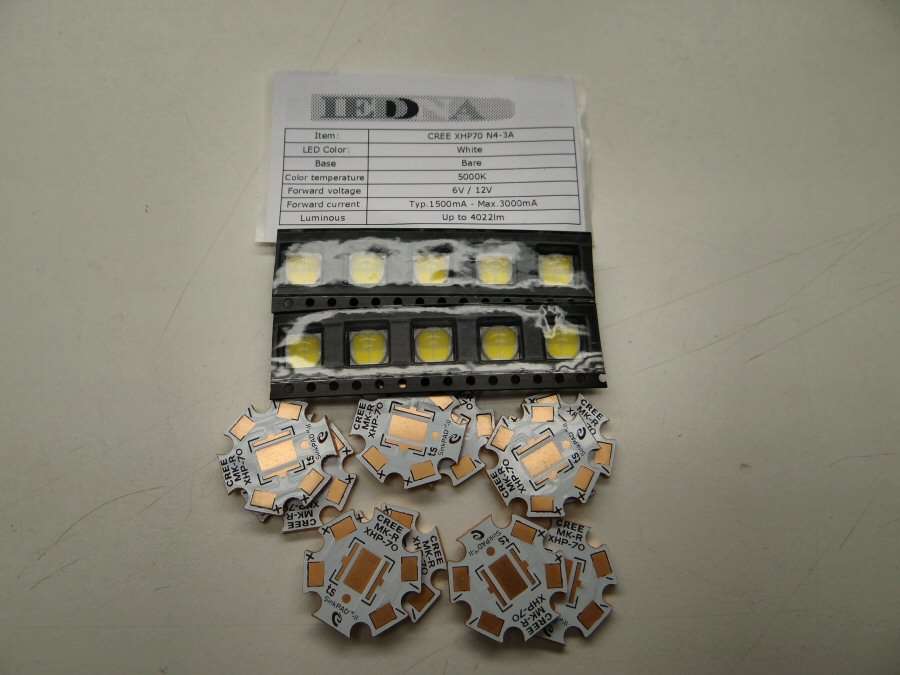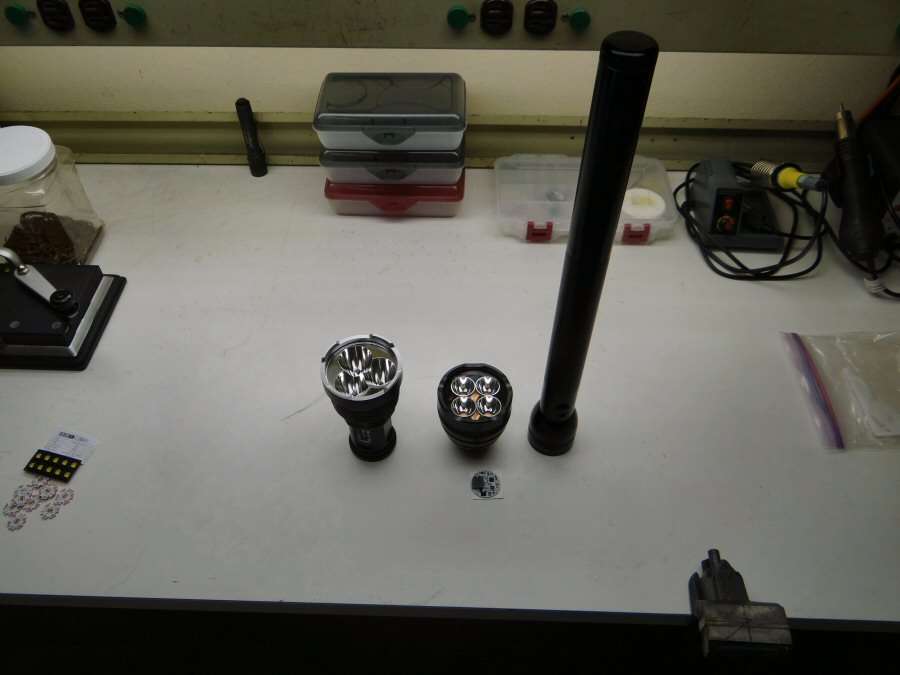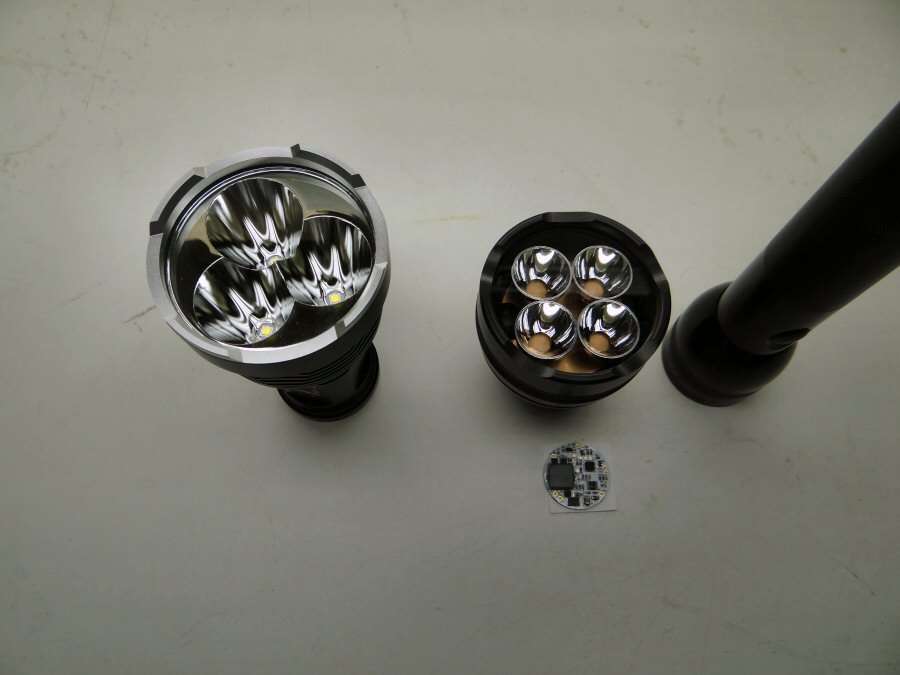Is that the one from your A6 test?
Too close to 7A for the thin aluminum star.
I wondered why I had bond wires on the brain, thanks for the reminder Dale ![]()
Here’s a crazy thought.
Gasoline dedome an xml2 then dab a tiny bit of solder onto each of the bare bond wires. Thereby beefing them up for higher current handling lower Vf? ![]()
Could be a crazy solution to the weaker current batch of XMLs?
Anyway that’s all far off topic.
Maybe, if the de-domed emitter isn’t rinsed, a small dab of solder paste could be applied to the bond wires and then a flame used to fire it up. ![]() Voila! Re-enforced bond wires!
Voila! Re-enforced bond wires!
Looking at the pads under the emitter of the XHP50 and 70, could they be cut with a razor to power each quadrant @4.2V? (Thats cutting the actual pads under the emitter, of deeper to reach a trace(s)). Of course the mcpcb would have to be modified as well. I know its been asked, but this might be a different approach.
I received a XHP 50 NW last night and set to run it at DD using 2x18650. Upon firing it up, it was bright NW but within a couple of seconds quickly turn CW and then bluish. Any idea what does this mean? Overheating? Or because of overvolting? I know it’s not an issue with batteries because normal pana 18650B and higher drain 18650PF all gave the same problem. Adding heatsinking doesn’t seem to help. Anyone encountered something similar with overvolting in an MTG2?
You must have it setup for 6V, 8.4V DD is too much. It sounds like you may not have permanatly damaged it though as is sounds like you have tried different cells and heatsinks.
Each time you test it, if it starts out as NW then turns blue, the same LED? If so, you are lucky and that is one tough chip!
Don’t try 8.4V DD again.
It’s already divided for 6V and 12V and pretty sure it can’t be subdivided any more.
Apparently you can feed it 8.4 but it better be on a DTP copper star stuck to a good sized sink or water cooled block.
Too high of a voltage. Needs to be regulated. One thing I have found with all of the four die Cree leds I have tried, is that they do not like non-regulated high voltage. All the ones I have done DD, have turned blue and died. Use a driver and regulate the amperage and the voltage will be controlled. Then you can run the led brighter than stock. A regulated 9 amps, will still be running a lower voltage than DD will.
How did you set it? What star was it on? Forward voltage is high at high power, so 2 cells should not be enough to overdrive it. I suspect you don’t have it on a direct thermal path star and it overheated. Use a SinkPAD or a Noctigon, a MAXToch star will work well too. A pair of PF type cell will almost certainly not be too much, not sure about the Efest 35A or Sony C5 level of cell with this one. The XHP70 handled it find though.
The only time I’ve seen an emitter go blue within seconds was under high amperage and with an aluminum star that did not have direct thermal path. Answer that question and I bet you have solved your problem.
I’ve got 3 XHP50’s on Noctigon stars pushing 9522 lumens out the front from 8 Efest IMR18350 cells. No blue light.
Thanks for the advice. It was on an aluminium star. I guess that may be the problem. The changing of colours happened within 2 sec and the heatsink is barely warm enough that’s why I wasn’t quite sure if it’s the alu star. Will try it on a noctigon and see.
Holy cow! That’s gotta be like an aircraft landing light!
The XHP’s are almost here and nobody has the Iris in stock. :_(
Have you tried Arrow Electronics? They usually have a large inventory and are quick to ship, good or even excellent pricing as well.
They say they have 3 of the CA10908 that is supposedly designed for an Osram, bet it’ll work for the XHP as well.
This is what I wanted. Or is the one you suggested a better reflector for the XHP70?
https://parts.arrow.com/item/detail/ledil-oy/cn11770-iris#2nng

I tested the XHP70 again last night, now mounted on a XHP70 Sinkpad, with the romantically wandering traces avoided by scratching some masking away, does not look pretty but it works alright. What is most important is that the thermal path of the middle pad has improved compared to my makeshift board using a XM-L Sinkpad and copper bits.

It is the exact same led as the first test and I plot the results together the makeshift board results because that is pretty interesting: at high currents this led really wants a good thermal path:

As you can see, the led has suffered somewhat from the 15A treatment of the first test: the output is a tad lower and the voltage a bit higher. But over 6.6A that effect is taken over by the better thermal path of the XHP70 board. It maxes out now at 11-12A.
Still my numbers are very low compared to Dale's numbers, so after cooling down I did some quick tests that were done more like how Dale measures with his flashlights: still the board was on the copper mount but there was no active cooling (fan out), and I went straight to the target current (I tested 8A and 12A), then looked for 1 minute every 10 seconds at the light output:
| 8A 0 seconds | 5340 |
| 8A 10 seconds | 5280 |
| 8A 20 seconds | 5230 |
| 8A 30 seconds | 5190 |
| 8A 40 seconds | 5140 |
| 8A 50 seconds | 5100 |
| 8A 60 seconds | 5050 |
| 12A 0 seconds | 6631 |
| 12A 10 seconds | 6258 |
| 12A 20 seconds | 6164 |
| 12A 30 seconds | 6024 |
| 12A 40 seconds | 5838 |
| 12A 50 seconds | 5744 |
| 12A 60 seconds | 5557 |
That helps! apparently at very high currents there is a noticable difference between measuring at 30 seconds and measuring at 'steady state' like I do in my tests. These numbers look a bit more like Dale's, and any difference leftover I am willing to explain by different calibrations or differences within a led bin , or he used a different bin. And my led was already tortured, as can be seen in the graph above.
To get the maximum out of the led I turned the current from zero to 15A in a moment and for a nanosecond I measured over 7000 lumen.
My numbers were from an actual light build, reflector, lens, batteries, real world. So you’ve proven that the losses compute and the emitter is capable of some very serious output. Thanks Jos! :bigsmile:
I was beginning to wonder if that test of mine had been a fluke or something. ![]()
Jubeldum, you might give SinkPAD a shout out as they are a licensed Ledil dealer and have the Ledil District Manager in house. ![]()
Send an email inquiring as to availability of that part number to abdul.aslami@ledil.com
15A power supply! That's pretty sweet. I have had mine go up over 10A before, but it's only rated for 10A so I'm not sure if something will break or go nuts if I push it that hard. I have used a buck converter to push the MT-G2s over 13A with the power supply at a higher voltage, but not direct drive.
Looks like after 9A-10A you're not getting much more output.
My XHP70 leds came today! LEDDNA sent me 10 of the 5000k XHP70 N4 3A leds. I already have the mcpcbs and the patients waiting on surgery, so it's going to be a long week-end. Billy did a great job of getting them out and they were packaged well and arrived quickly.



The four up is a light that used to be 4xP7 leds. Now it will be 4xXHP70 leds in series, with one of George's HBFlex drivers and a 6D Maglite with 5x26650 cells in it. 3 amps per led.
The other light is the SP03 and it will have 3xXHP70 leds at nine amps each. Well, maybe... I think it will have a custom FET driver in it, done by RMM. Not positive yet, maybe a 7135 driver.
That leaves me 3 leds for some Maglite mods.